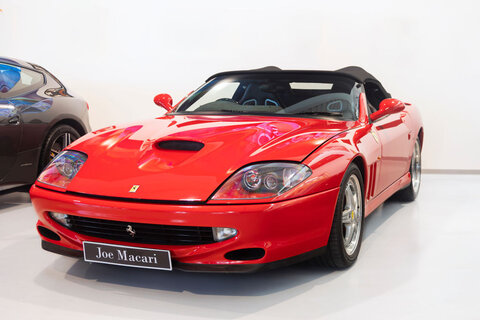Travis Fisher and Joshua Loucks
The 1981 song Red Barchetta by the band Rush tells the story of a man who gleefully commits a weekly crime—driving a brilliant red Ferrari 166MM (barchetta being Italian for “little boat/craft”) and ultimately outsmarting and outdriving the authorities. The story is a warning to people who love to drive because, in the dystopian future setting of the song’s plot, a “motor law” makes driving the car illegal.
The song itself is an exhilarating ride. If you haven’t listened to it recently, do your ears a favor and check it out here. And the political lesson is clear: a future in which the government tries to arrest you for driving a vintage Ferrari—or any car you like—would be awful and should be relegated to science fiction.
Not so fast, say the officious pencil pushers at the US Environmental Protection Agency, who issued a regulation earlier this year that would force a transition to electric vehicles (EVs). The EPA expects the tailpipe emissions standards to push two-thirds of new vehicles sold in 2032 to be EVs (today, EVs make up something like 7.6 percent of new vehicles sold in the United States).
Opponents of EV mandates typically cite things like range anxiety (which prevents the long drives that are “a hallmark of American car culture”), higher cost (EVs cost over $56,000 compared to $48,000 for gas-powered vehicles), and the lack of available charging infrastructure (despite the $7.5 billion in the 2021 Infrastructure Investment and Jobs Act to expand this infrastructure, the government had spurred the construction of just eight electric charging stations in over two years).
These are valid concerns, but what if you just like driving a car with an internal combustion engine? We have nothing against EVs. But if you love driving a gasoline-powered vehicle (for whatever reason), by God, this is America, and no one at the EPA should tell you what kind of car to love.
The formal name of the EPA rule is the “Multi-Pollutant Emissions Standards for Model Years 2027 and Later Light-Duty and Medium-Duty Vehicles.” Although the rule has a longwinded name, it would swiftly limit consumer choice for passenger vehicles. Under the guise of reducing “climate pollution,” the Biden-Harris administration’s EPA believes it has ample authority to reshape the American automotive industry.
How would an agency obtain such authority? Despite recent Supreme Court decisions to the contrary, the EPA has decided its sweeping new authority comes from existing statutes.
First, as summarized by Jonathan Adler in the Cato Supreme Court Review (an amazing resource), the 2022 decision in West Virginia v. EPA “rested on the longstanding and fundamental constitutional principle that agencies only have the regulatory authority Congress delegated to them” and found that “[e]xtraordinary assertions of regulatory authority… required a clear delegation from Congress.” Notably, WV v. EPA was the first case to invoke the “major questions doctrine” in a majority opinion by the Supreme Court.
Second, the 2024 decision in Loper Bright Enterprises v. Raimondo limited the deference agency decisions will receive from courts and officially ended the era of so-called “Chevron deference.” Interestingly, the doctrine of Chevron deference was named for the 1984 case Chevron v. NRDC, which gave deference to—you guessed it—the EPA.
Taken together, these recent Supreme Court rulings illustrate how, thankfully, administrative law is beginning to side a little more with the freedom of the individual over the authority of the administrative state. They also show how untethered the EPA’s regulations have become from underlying statutes. Still, the EPA can’t help but shoot its shot—in fact, it has become effective at achieving its desired outcome even when it loses in court.
Defenders of the EPA’s rulemaking say it’s not a mandate, per se, but merely an emissions standard. My question back to them is: What’s the difference? If the result of an emissions standard is to limit choice and force an entire industry—and every American consumer—in a direction few of us want to go, can we at least call it a de facto mandate?
Further, what would stop the EPA from tightening its emissions standard even further and creating a real-deal EV mandate? The line is blurry. There’s even a separate EPA waiver program through which 17 states have now adopted California’s EV mandate.
Fortunately, Congress has a voice in this process. On the one hand, it could pass new legislation granting the EPA explicit authority to forcibly remove the internal combustion engine from American automobile markets. We don’t suspect that would be a popular policy. On the other hand, it could use the Congressional Review Act (CRA) to disapprove and reject the EPA’s rulemaking.
The latter is precisely what the House of Representatives did last week, in a bipartisan vote of 215 to 191. Under the structure of the CRA, the Senate would also have to pass the resolution, and then it would head to President Biden’s desk for signature. Given the likely veto from President Biden, the CRA would require a veto-proof majority. The margin in the House was approximately 53 percent, which would fall short.
We have a better idea. What if the types of vehicles we drive weren’t dictated by Congress or the EPA? What if the government got out of the auto industry altogether? Note that many of the major car manufacturers in the US have “curbed their EV ambitions in recent months” as they have become aware of the lack of demand for EVs. Maybe the American people know more about what they want than federal bureaucrats.
Vehicle mandates—de facto or direct—push us closer to the dystopian future imagined in Red Barchetta, when people have lost liberty and the pursuit of happiness. As the song warns, these mandates force us to comply with burdensome rules rather than allowing us the freedom to chart our own course. The “better, vanished time” in Red Barchetta is right now, and we should fight to keep it.

